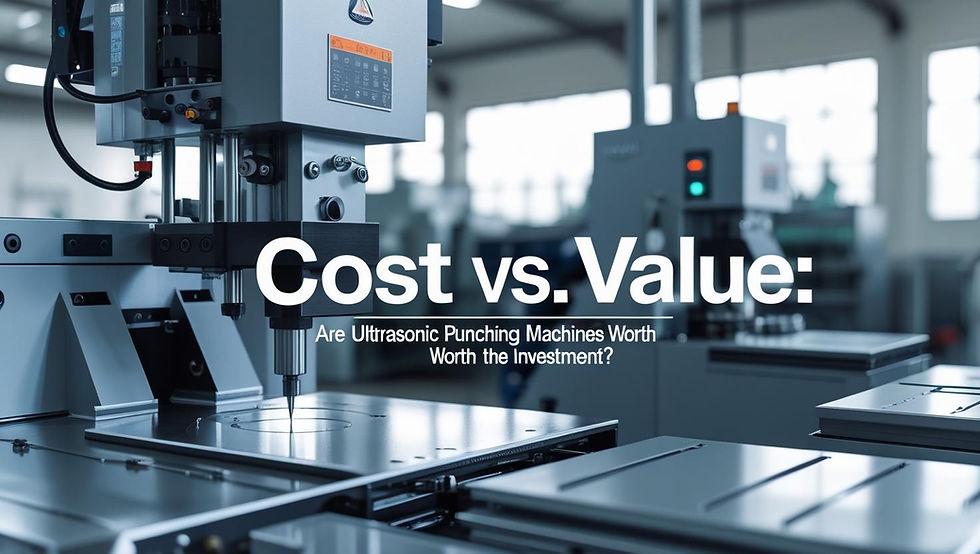Ultrasonic Punching vs. Traditional Methods: A Comparative Analysis
- ztzgsteeltech
- May 29
- 4 min read

In modern manufacturing, precision, speed, and cost-efficiency are not just goals—they are requirements. One process that stands at the heart of industrial production is material punching. But how companies punch, cut, and shape materials has changed significantly with the emergence of ultrasonic punching technology.
Whether you’re managing a textile line or overseeing automotive component production, understanding the differences between ultrasonic punching vs traditional methods can guide better investment and production decisions. Let’s dive into a comparative analysis that uncovers the strengths, weaknesses, and best-fit applications of each approach.
Ultrasonic Punching vs Traditional Methods
Ultrasonic punching is a high-frequency, vibration-based process, whereas traditional methods rely on mechanical force, typically utilizing hydraulic, pneumatic, or mechanical press systems. This single distinction influences nearly every aspect of performance, cost, and application.
Overview of Ultrasonic Punching
Ultrasonic punching utilizes high-frequency mechanical vibrations, typically exceeding 20 kHz, to generate rapid reciprocating motion at the tool tip. This vibration cuts through materials with precision, requiring minimal downward force.
Key Characteristics:
Minimal mechanical pressure
High-frequency vibration (20–40 kHz)
Excellent for thin, soft, and multi-layered materials
Often used in textile, plastic, medical, and packaging industries
Overview of Traditional Punching Methods
Traditional methods use physical force through:
Mechanical punching machines – powered by flywheels and cranks
Hydraulic punching – uses pressurized oil
Pneumatic punching – utilizes compressed air
These are commonly used in heavy-duty operations, such as metal fabrication, automotive manufacturing, and large-scale production.
Comparison Criteria
To assess both methods, we’ll evaluate:
Precision and accuracy
Speed and processing efficiency
Material compatibility
Tool wear and maintenance
Energy consumption and environmental impact
Safety
Cost-effectiveness
Precision and Accuracy
Ultrasonic Punching:
Exceptional accuracy with minimal edge fraying
Ideal for delicate or thin materials
High repeatability with close tolerances
Traditional Methods:
Good for metals and thick materials
May produce burrs or deformation
Requires frequent calibration for high precision
Verdict: Ultrasonic wins in precision-critical applications.
Processing Speed and Efficiency
Ultrasonic Punching:
Faster setup and execution for soft materials
Minimal cycle time with low vibration to the surroundings
Traditional Methods:
Slower for fine work, but efficient for bulk punching
Larger, more powerful presses offer consistent cycle rates
Verdict: Tie. Depends on the material type and production scale.
Material Versatility
Ultrasonic Punching:
Works excellently on synthetic textiles, thermoplastics, films, and foils
Handles multi-layered or laminated materials without heat damage
Traditional Methods:
Better suited for metals, composites, and harder substances
Limited flexibility with thin or fragile materials
Verdict: Choose based on material—ultrasonic for soft, traditional for hard.
Tool Wear and Maintenance
Ultrasonic Punching:
Less tool wear due to minimal contact pressure
Lower replacement frequency
Requires occasional tuning and transducer maintenance
Traditional Methods:
High wear rate, especially on cutting dies
Frequent sharpening and part replacement are needed
Verdict: Ultrasonic provides lower maintenance overhead.
Energy Efficiency and Environmental Impact
Ultrasonic Punching:
Consumes significantly less energy
Quieter and generates little to no waste
No lubricant or coolant required
Traditional Methods:
High power consumption, especially in hydraulic presses
Generates noise, heat, and metal waste
Verdict: Ultrasonic is more sustainable and energy-efficient.
Operational Safety
Ultrasonic Punching:
Minimal mechanical force = lower injury risk
Cleaner work environment with no hot surfaces
Traditional Methods:
High-pressure systems pose crush hazards
Loud operations and moving parts increase injury potential
Verdict: Ultrasonic systems are safer by design.
Detailed article on how to start an ultrasonic product business using this detailed guide.
Cost Comparison
Ultrasonic Punching:
Higher initial investment
Lower running and maintenance costs
Long-term ROI through durability and energy savings
Traditional Methods:
Lower upfront costs
Higher energy and tooling expenses
Ideal for low-budget, high-force applications
Verdict: Traditional is budget-friendly upfront; ultrasonic wins in the long term.
Industrial Applications
Ultrasonic Use Cases:
Textile and non-woven fabric processing
Medical mask and gown manufacturing
Plastic packaging and film cutting
Traditional Use Cases:
Steel and aluminum sheet punching
Automotive part manufacturing
Industrial construction and structural metal works
Advantages of Ultrasonic Punching
No burrs or edge fraying
Low mechanical stress
Ideal for precision work
Energy-saving and eco-friendly
Quiet and clean operation
Advantages of Traditional Punching
Handles hard, thick materials
Simple mechanical design
Lower cost for basic operations
Familiar to most industrial teams
Challenges of Ultrasonic Punching
Higher cost of entry
Requires training and tuning
Limited to certain material thicknesses
Challenges of Traditional Methods
Frequent tool wear
Noisy, less safe
Higher energy and environmental impact
Recent Innovations and Trends
Integration of smart sensors in ultrasonic systems
Real-time diagnostics and self-calibration features
Compact, modular machines for easy installation
Multi-functional systems that combine cutting, sealing, and punching
Choosing the Right Method for Your Industry
Ask these questions:
What materials do you primarily use?
How important is precision?
What is your production volume?
Are you targeting sustainability or cost-efficiency?
For textiles, plastics, and precise fabrication—go ultrasonic. For heavy-duty, metalwork-focused jobs, traditional methods still hold strong.
Conclusion
Choosing between ultrasonic punching vs traditional methods isn’t about which is better—it’s about which is better for your needs. Ultrasonic punching machine supplier provides machines that excels in precision, efficiency, and sustainability, while traditional systems remain the go-to for raw power and budget-conscious operations.
Before investing, evaluate your production goals, materials, and operational capacity. The future of manufacturing is moving toward smart, clean, and efficient systems, and ultrasonic punching is leading the way.



Comments